Hack 28. Experiment with Different Cartographic Projections


There are lots of ways to depict a round planet on a flat plane, but, fortunately, there are also versatile tools for exploring the aesthetic compromises embodied in different cartographic projections.
One of the main challenges of mapping our world is how to represent its round surface on the flat plane of a map. Most projections involve some process of projecting Earth's spheroid surface directly onto a flat plane, or onto the surface of another figure which can be "unwrapped" into a flat plane without warping or tearing, such as a cylinder or cone. The projection surface may be aligned in a conventional, transverse (at a right angle), or oblique (i.e., at some other angle) fashion.
The projection process necessarily introduces distortions of one kind or another. Different cartographic projections make different choices about the trade-offs inherent in preserving one or more aspects of the planet's surface, at the expense of others. Table 3-1 outlines some of the properties that projections can preserve or distort.
|
Property |
Map feature |
Preserved by... |
|---|---|---|
|
Area |
Relative areas of landmasses |
Peters, Mollweide, Albers Equal-Area Conic |
|
Conformality |
Shapes of landmasses |
Mercator, Stereographic, Lambert's Conformal Conic |
|
Direction |
The relative direction between two points (useful for navigation) |
Mercator, Gnomonic |
|
Distance |
Distances from the center of the map |
Azimuthal Equidistant |
|
Scale |
Ratio of distances on the map versus distances in the world |
Many projections, but typically only along meridians or standard parallels |
|
The University of Hawaii's Generic Mapping Tools, or GMT, offer a useful way of experimenting with different map projections. GMT was originally intended for generating maps for inclusion in scientific publications, incorporating a series of useful command-line tools for plotting maps in a broad variety of projections. In addition, GMT includes vector data of reasonable quality of coastlines and political boundaries for the whole world, so it makes worthwhile maps right out of the box. Naturally, it's published under the GNU Public License, so the code and data are all "free as in freedom."
You can get GMT from its homepage at http://gmt.soest.hawaii.edu/. In general, you can follow the installation directions. Binaries are available for Windows from the FTP site, which can be accessed via the mirrors page. If you're running Debian or OS X, we recommend getting GMT from APT or Fink. If you're running Fedora Core or another RPM-based distribution, you can get binary packages of GMT from the Mapping Hacks RPM repository at http://mappinghacks.com/rpm. If you decide to install from source, you can have the web site generate an installation script for you, which, when run, will download and build GMT automatically. If you choose this route, you'll probably want to select shared libraries built with gcc.
|
Because of its origins in scientific publishing, GMT's primary output format is PostScript, which is great if you plan to make hardcopies of your mapsbecause, as a vector format, PostScript can be scaled to any sizebut a little unwieldy otherwise. Ghostview (a.k.a. gv) is the ideal way to view PostScript on Linux, and GSview is a solid, free PostScript viewer for Windows and OS X. You can find out more about these viewers at http://www.cs.wisc.edu/~ghost/. You should also be able to load and edit PostScript in most modern image editors, including the GIMP, in order to export your maps to other formats, like PNG or JPEG.
|
3.8.1. Cylindrical Projections
Frequently used cylindrical projections include Mercator, Transverse Mercator, and Peters projections.
3.8.1.1 The Mercator projection
The one projection that nearly everyone is familiar with, the Mercator, is a classic example of a cylindrical projection, which maps the surface of the planet onto that of a cylinder, and then unwraps it into a flat plane. The following GMT command renders a world map as a Mercator projection:
$ pscoast -JM18c -R-180/180/-75/85 -Bg30/g15 -G64/255/128 -S64/128/255 > mercator.ps
We use the pscoast command from GMT to generate a map of the world's landmasses. The -JM18c parameter requests a Mercator projection 18 centimeters wide, which should be big enough to fill a page, more or less. The -R command specifies the area we want mapped, west-by-east and south-by-north, with west longitudes and south latitudes given as negative values. -Bg30/g15 tells GMT we want a grid spaced every 30 degrees longitudinally and every 15 degrees latitudinally. Finally, -G and -S specify the fill colors for land and water areas, respectively. The colors are given in red/green/blue components, so the previous command would yield a light green for land areas and a light blue for water.
|
Like any good Unix tool, pscoast writes directly to its standard output. We've used shell redirection to dump the map to a file called mercator.ps, which is shown in Figure 3-16.
Figure 3-16. The standard Mercator projection, generated with GMT
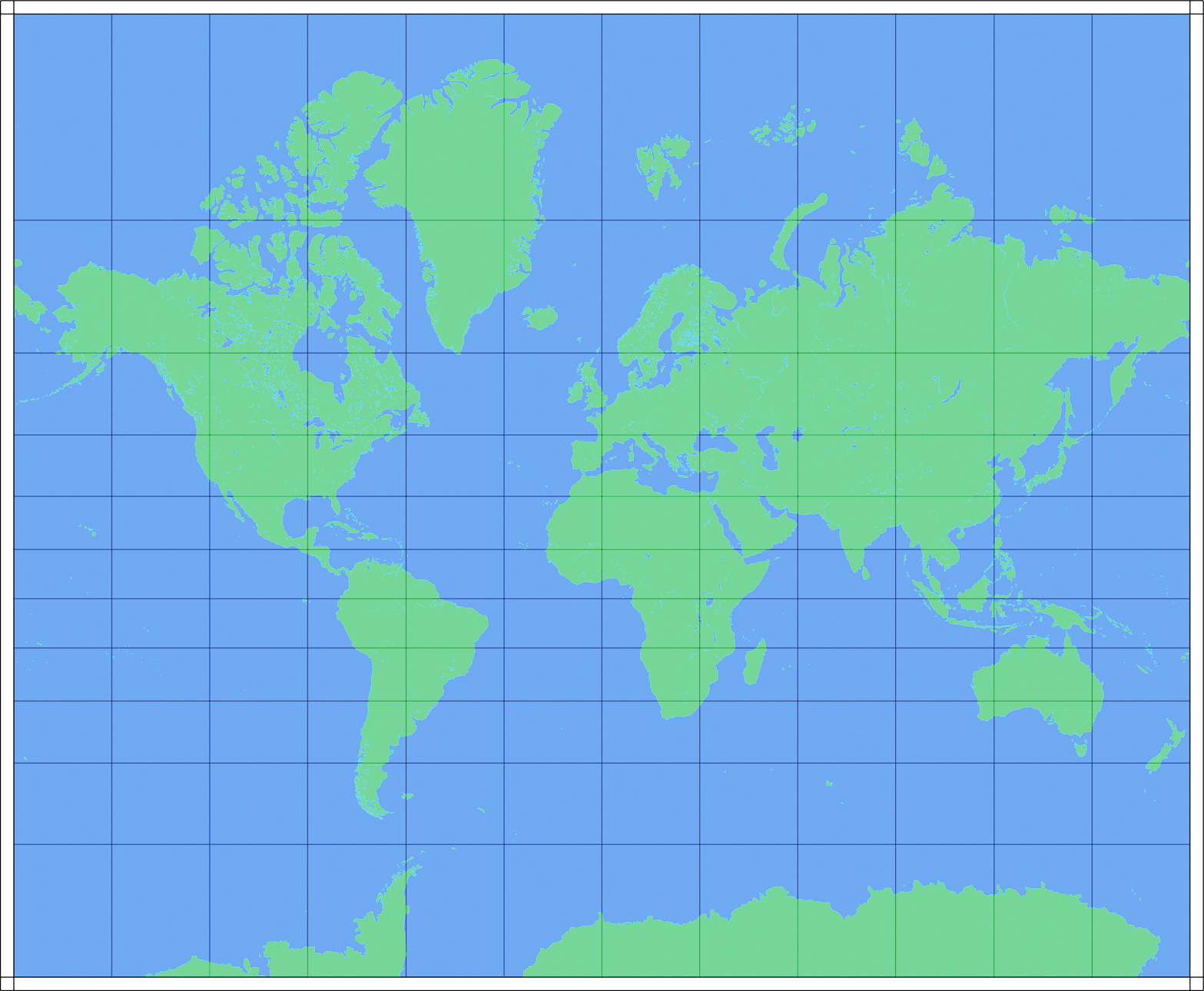
Although the Mercator map distorts land area terribly near the poles, it has one enormously useful property, which is that any straight line on a Mercator projection follows a constant bearing in the real world. You can head off in the exact direction indicated by the map and actually arrive at the intended destination. (This can't be done with most cartographic projections, which ordinarily bend straight lines in the real world.) This direction-preserving property has made the Mercator projection valuable to marine navigators for the last 450 years!
3.8.1.2 The Transverse Mercator projection
In [Hack #26], we discuss the enormous utility of the Transverse Mercator projection for mapping small regions of the world with minimal distortion, but they can be used to map larger regions as well. The "transverse" aspect of the Transverse Mercator projection refers to the fact that the cylindrical surface used in the projection gets turned on its side, so that the enormous polar distortion associated with the Mercator projection ends up being pushed out to the sides of the map. This property makes the Transverse Mercator projection useful for mapping regions longer north-by-south than east-by-west, like Chile, Great Britain, or a UTM zone. The following command generates a map as a Transverse Mercator projection similar to one used by the British National Grid system:
$ pscoast -JT0/18c -R-11/2/50/59 -G64/255/128 -S64/128/255 -W3 -Di -P > british_isles.ps
The -JT0/18c parameter requests a Transverse Mercator projection centered at 0 degrees longitude, with a width of 18 centimeters. The -R, -G, and -S parameters are used as explained earlier. The -W parameter asks GMT to outline the landmasses, in this case with a line 3 pixels wide. The -Di parameter requests a map based on intermediate resolution data, rather than the default low-res vectors. Finally, -P requests the map be presented portrait orientation, instead of the default landscape orientationthis is a map of an area longer north-by-south, after all. Figure 3-17 shows the result.
Figure 3-17. A Transverse Mercator projection of Great Britain and Ireland
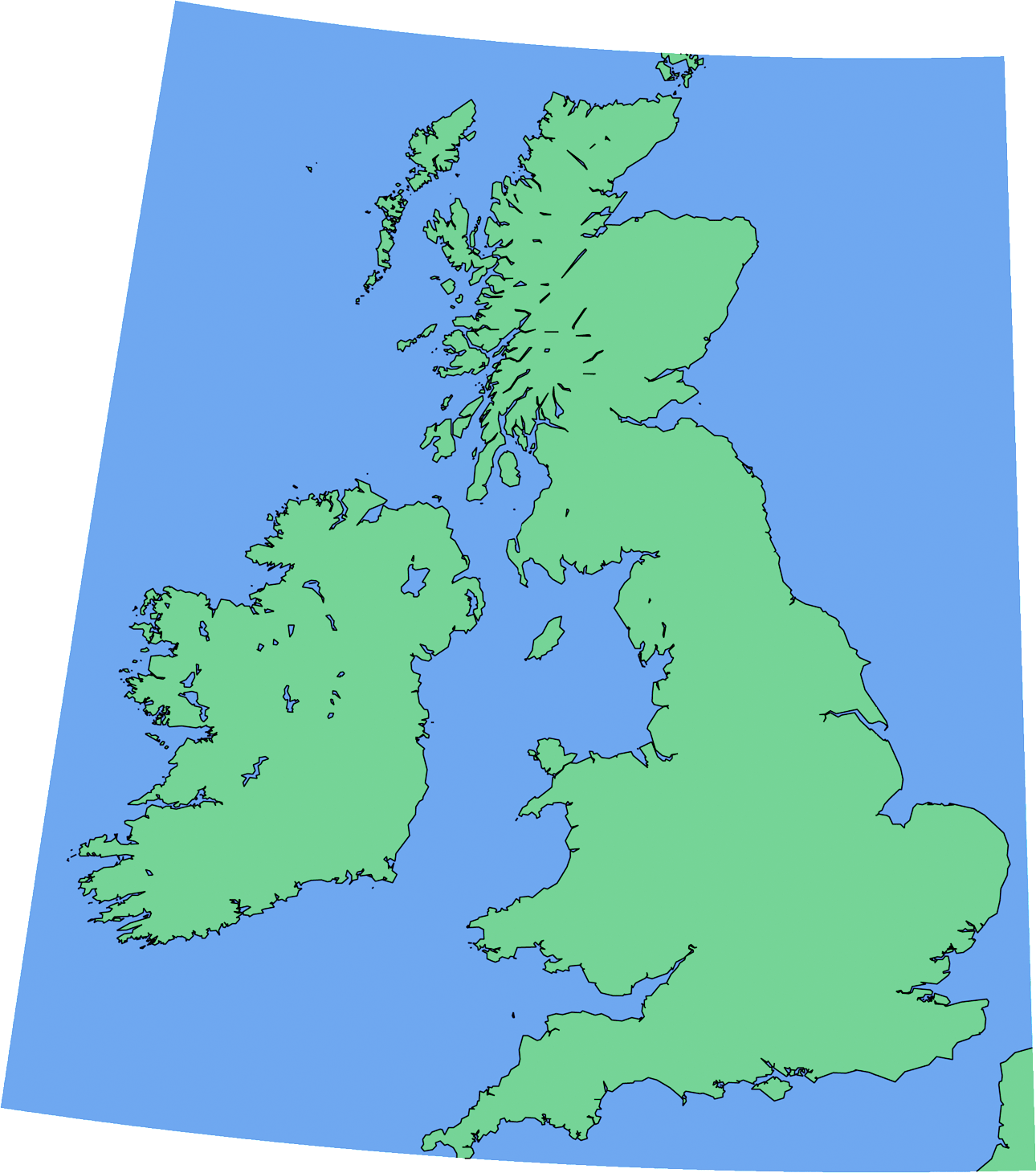
|
Incidentally, you can quite visibly demonstrate the manner in which the Transverse Mercator distorts landmasses away from the central meridian toward the sides, rather than the top and bottom, by mapping the whole world with it, using the following command:
$ pscoast -JT0/18c -R-180/180/-85/85 -Bg30/g15 -G64/255/128 -S64/128/255 > world_tm.ps
You can see the result in Figure 3-18. Note the extreme distortion of Central America, western South America, southern India, Sri Lanka, Indonesia, and so on; these are all regions that lie around 90ºE or 90ºW, near the equator. Meanwhile, Greenland and Antarctica, two places often given short shrift in cartographic projections, are shown in their proper size and shape, although Antarctica is bisected in this projection. Try setting the central meridian of a Transverse Mercator world map to your home longitude and see what you end up with.
Figure 3-18. The world in a Transverse Mercator projection, centered on 0º longitude
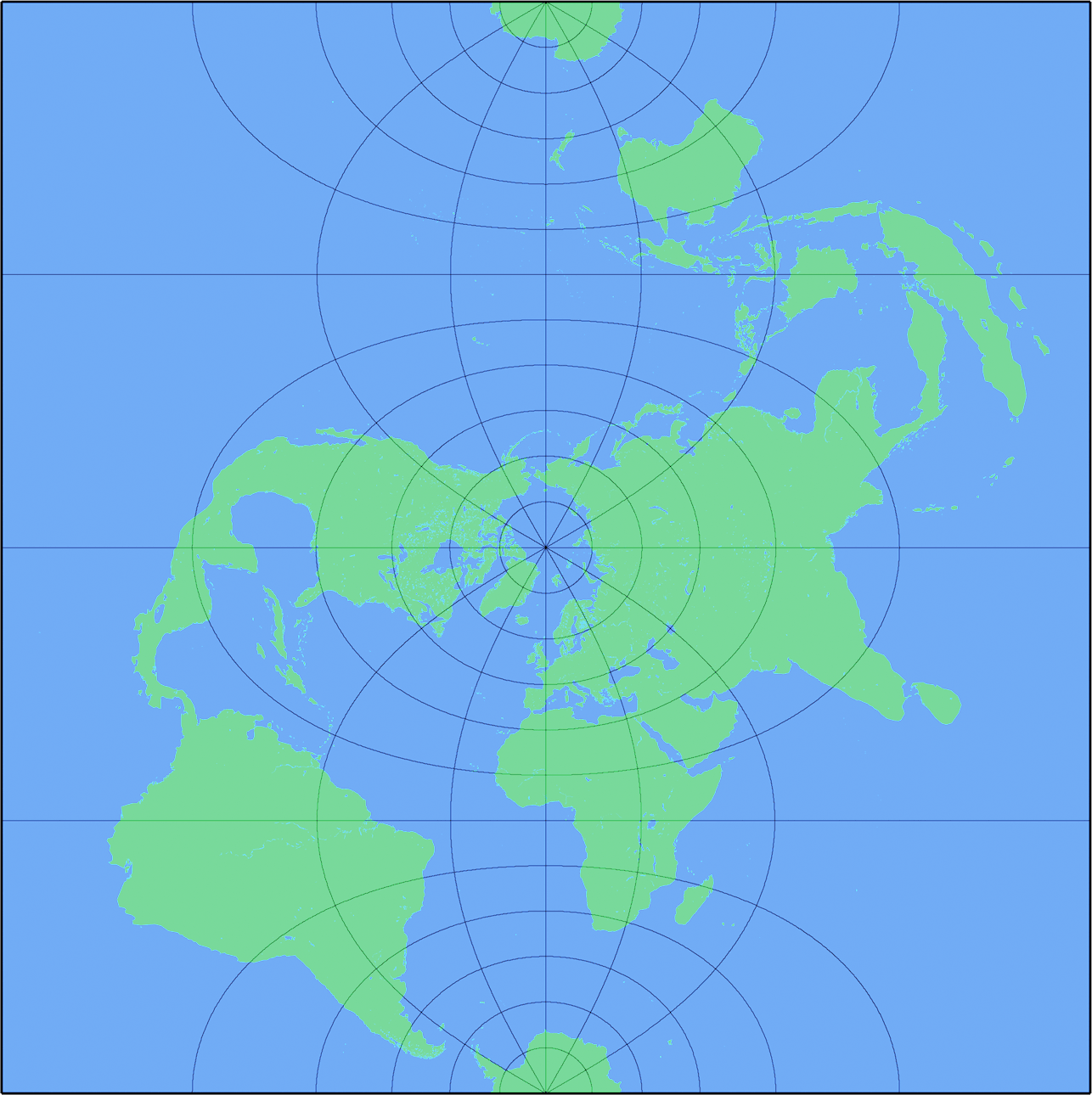
3.8.1.3 The Peters projection
Other compromises can be made with cylindrical projections. One response to concerns that the Mercator projection distorts the perceived size, and hence the perceived importance, of northern countries at the expense of equatorial countries was the promotion of the Peters projection. The Peters projection is a special case of the basic cylindrical projection, with the standard parallels placed at 45º North and South. Consequently, size and scale are preserved in the Peters projection at those latitudes but distorted elsewhere, in order to preserve relative size overall. Although this makes the shapes of most countries look a bit strange (except for those along the 45th parallel, like Germany or France), the result is a map that at least shows the correct size relationships between countries.
The following pscoast command generates a Peters projection map of the world:
$ pscoast -JY0/45/18c -R-180/180/-85/85 -Bg30/g15 -G64/255/128 -S64/128/255 -N1 -A5000 > peters.ps
Figure 3-19 shows the map itself. We've used the -JY0/45/18c parameter, which requests a map in the basic cylindrical projection, with its central parallels at 45º. To see what other kinds of maps you can make with the cylindrical projection, try playing with the central meridian and parallels. We've also used the -N1 option to display international borders, and the -A option to filter out features such as lakes and islands that have less than 5,000 km2 total area, to make the map a little neater.
Figure 3-19. The world in a Peters projection
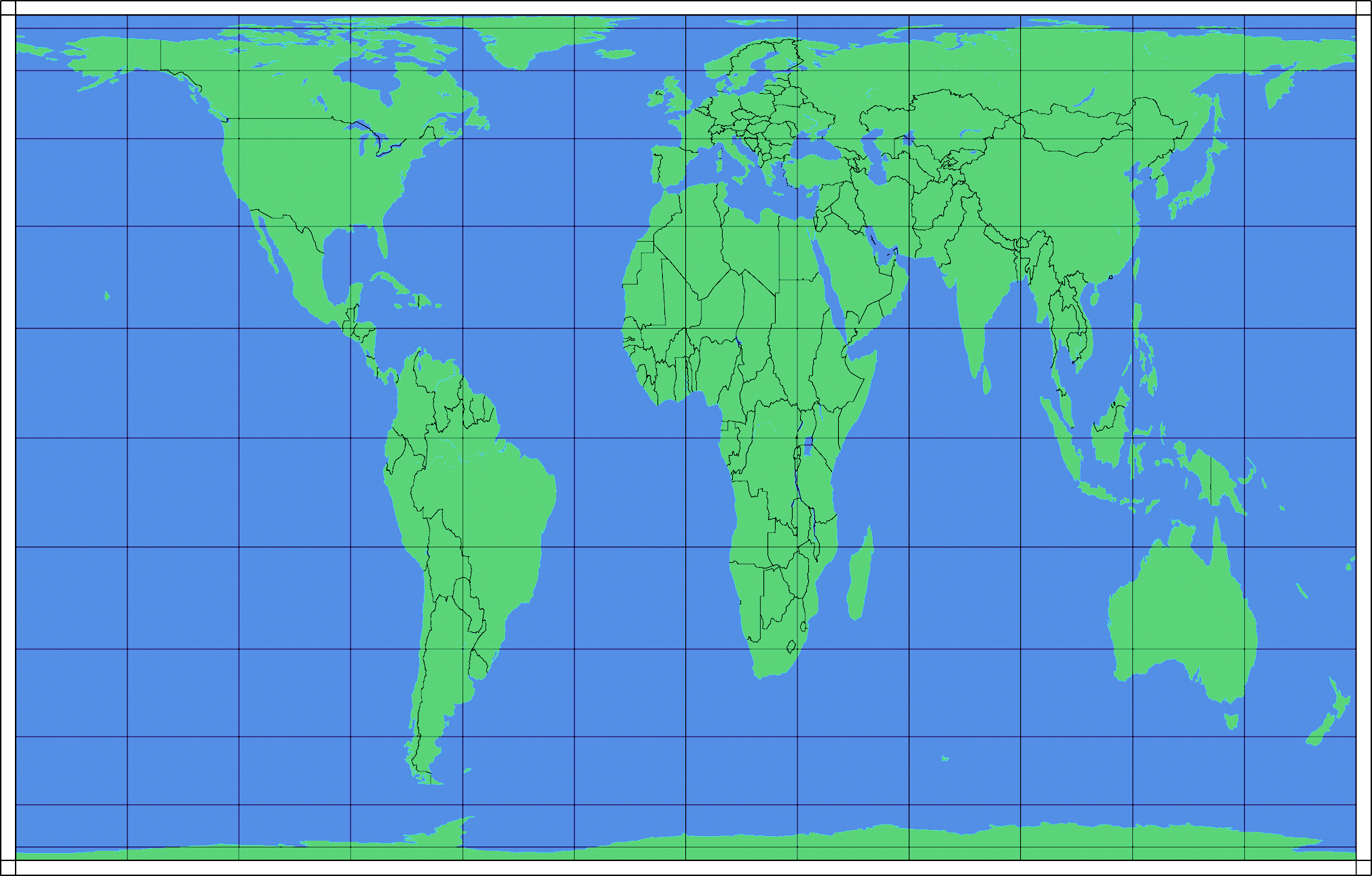
3.8.1.4 The Equidistant Cylindrical projection
The Equidistant Cylindrical (Plate Carrée), projection is a cylindrical projection that treats all lines of latitude as having the same length. Although this results in considerable distortions of scale away from the equator, it makes the calculations needed to plot things on the map trivial, to say the least. pscoast generates Equidistant Cylindrical maps with the -Jq option. We discuss this projection in great detail in [Hack #29] .
3.8.2. Azimuthal Projections
In contrast to cylindrical projections, azimuthal projections are created by projecting, or in some way unwrapping, Earth's surface on to a flat plane. This style of projection lends itself very well to mapping the poles.
3.8.2.1 Stereographic projections
The following pscoast command plots a stereographic projection of the North Pole, which can be seen in Figure 3-20:
$ pscoast -JG0/90/18c -R-180/180/45/90 -Bg30/g15 -G64/255/128 -S64/128/255 -N1 -A5000 > n_pole.ps
The -JG0/90/18c parameter gives us a stereographic projection of the upper half of the Northern Hemisphere, oriented to 0º longitude, and centered on 90º Northi.e., the North Pole. The stereographic projection is essentially the image that would result if a light were projected through the planet from the opposite side of the planet onto a flat plane touching the surface at exactly one point. As it happens, the stereographic projection is a conformal projection, which, if you'll recall, means that it preserves the shapes of landmasses. Interesting results can be created if different center points and extents are chosentry it!
Figure 3-20. The North Pole, shown in a stereographic projection
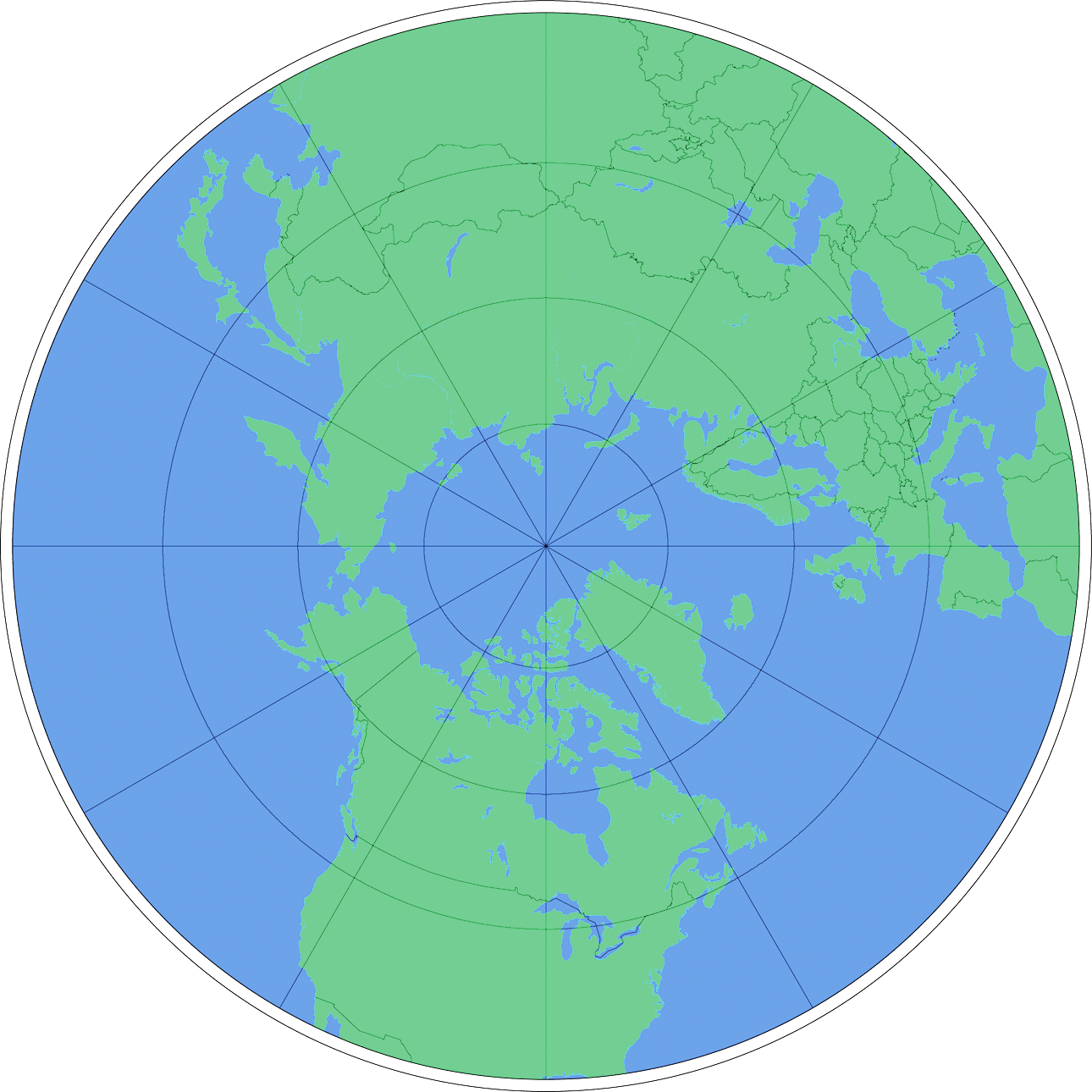
3.8.2.2 Orthographic projections
The orthographic projection shows a single hemisphere in perspective. Although it distorts both area and direction, the orthographic projection is popular because, well, it looks like half a globe. pscoast generates orthographic projections with the -JG option. Figure 3-1 from [Hack #22] features a GMT-generated orthographic map centered on San Francisco.
3.8.2.3 The Azimuthal Equidistant projection
The Azimuthal Equidistant projection is just what it sounds like: an azimuthal projection that preserves distance and direction from the center of the map. The result can look pretty interesting. Figure 3-21 shows an Azimuthal Equidistant projection of the world, centered near New York City at 40ºN 75ºW, as generated with the following command:
$ pscoast -JE-75/40/18c -R-180/180/-90/90 -Bg30 -G64/255/128 -S64/128/255 -A5000 > nyc.ps
Figure 3-21. The world shown relative to distance and direction from New York City
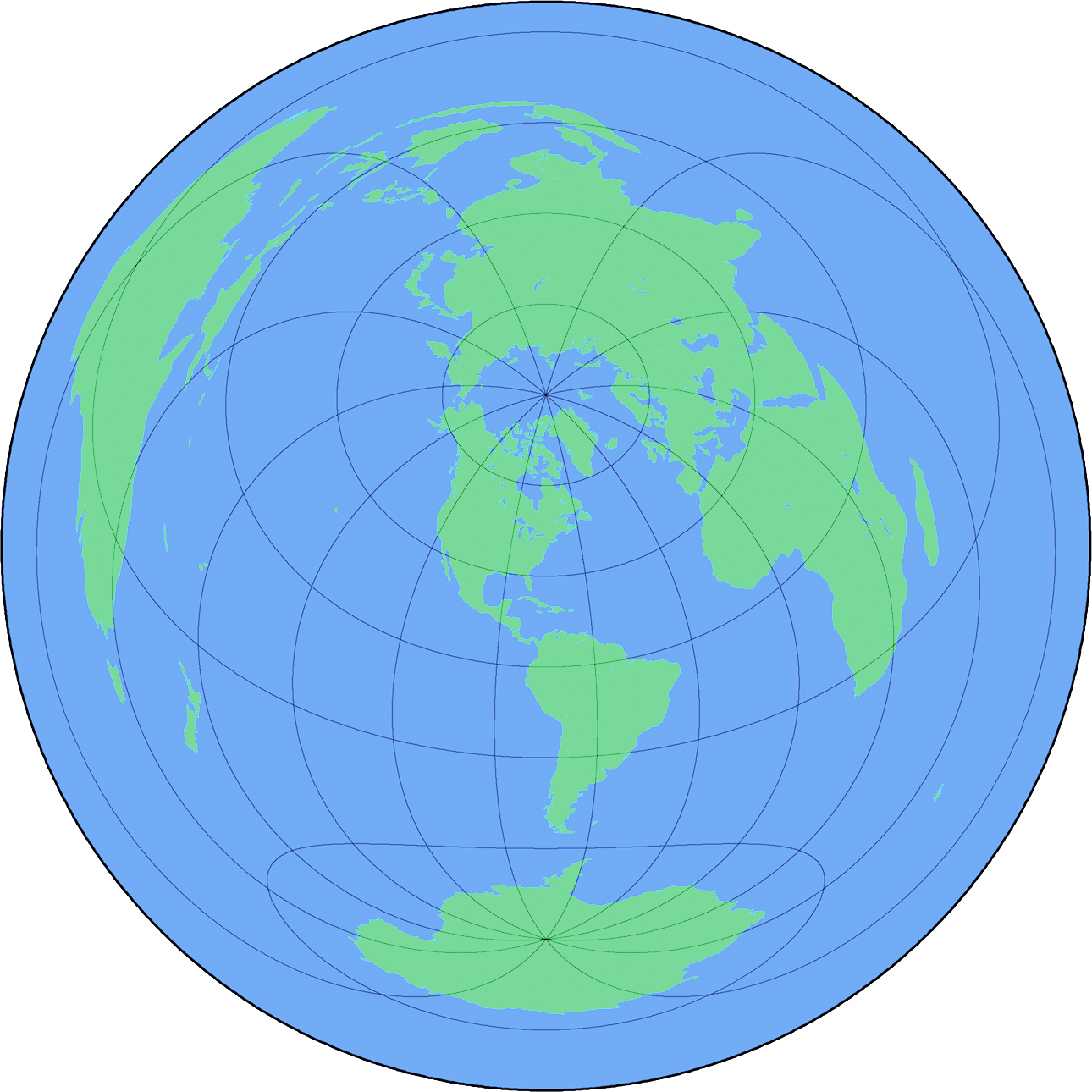
The big blob on the left side is Australia, which is greatly distorted in shape and size due to its extreme distance from New York. In contrast, Figure 3-22 shows the same projection centered in the vicinity of Sydney, at 30ºS 150ºE.
Figure 3-22. The world shown relative to distance and direction from Sydney
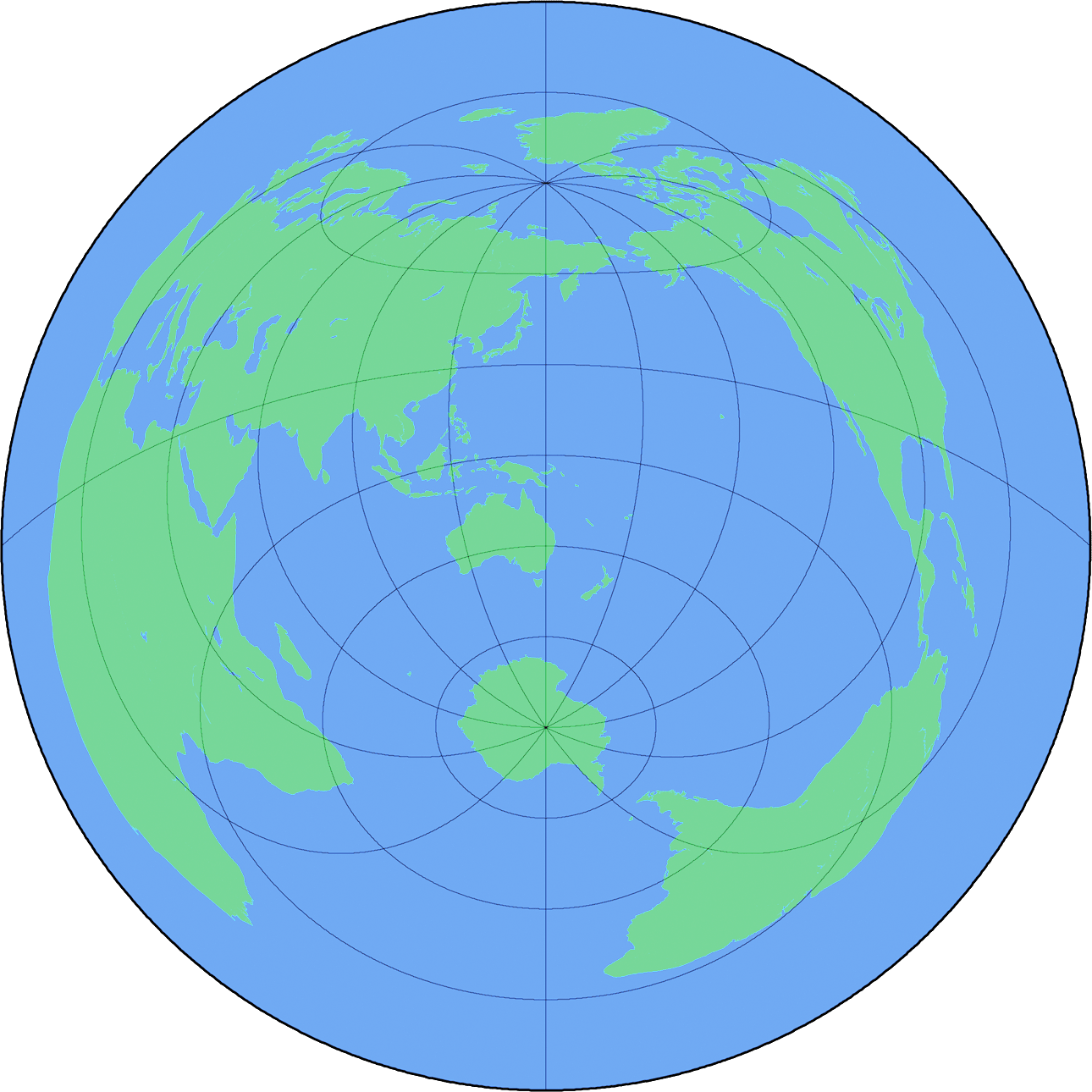
3.8.2.4 The Gnomonic projection
Other types of azimuthal projection are possible, as well. The Gnomonic projection is similar to the stereographic projection, except that the "light" source used to project the planet's surface is placed at the center of the planet, instead of at the side opposite the point that the projection surface touches the planet. The following pscoast command generates a Gnomonic projection extending 75 degrees in each direction from 51ºN 0ºE, near London, as shown in Figure 3-23:
$ pscoast -JF0/51/75/18c -R-180/180/-90/90 -Bg30 -G64/255/128 -S64/128/255 -A5000 > gnomonic.ps
Figure 3-23. A Gnomonic projection of the world, centered near London
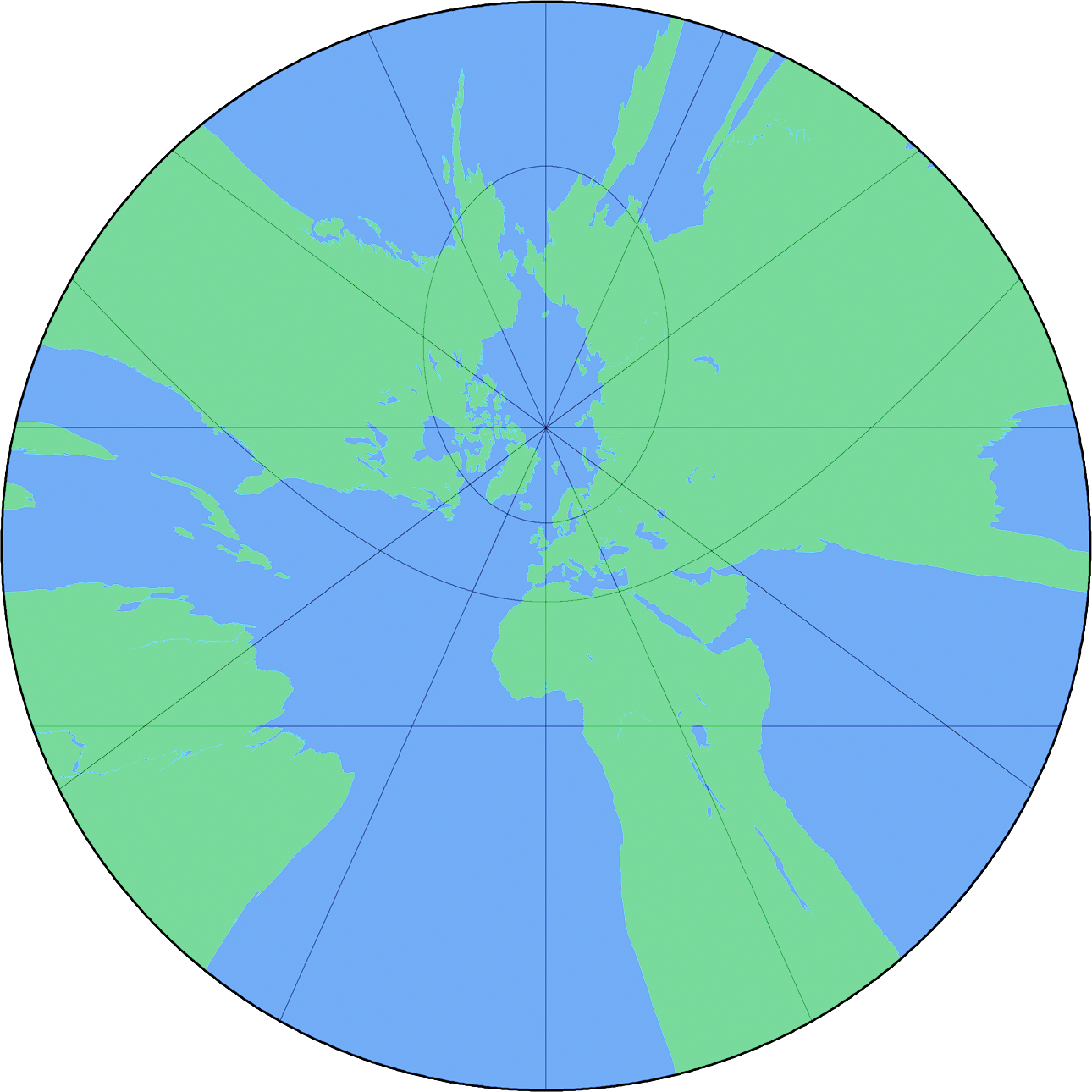
The really nifty thing about the Gnomonic projection is that every straight line on a Gnomonic projection follows a great circle, which is the shortest line between two points on the surface of a globe. This makes the Gnomonic projection exceptionally useful for air navigation, in much the same way as the Mercator is useful for marine navigation.
The Gnomonic projection can also be applied to project Earth's surface onto the faces of a polyhedron, such as a cube, instead of a single flat plane. Buckminster Fuller's Dymaxion projection is a special example of a Gnomonic projection of Earth's surface onto an icosahedron, a 20-sided three-dimensional figure. We discuss how to make use of Fuller's projection in [Hack #31] .
3.8.3. Conic Projections
Yet a third type of projection can be constructed by projecting a globe onto the surface of a cone placed over the top of it. If cylindrical projections are traditionally used to map equatorial regions with a minimum of distortion, and azimuthal projections to map polar regions similarly, then conic projections are traditionally used to map the middle latitudes most effectively.
3.8.3.1 Lambert's Conformal Conic projection
With the following command, we can use Lambert's Conformal Conic projection to make a quite reasonable map of Europe, as shown in Figure 3-24:
$ pscoast -JL15/50/40/65/18c -R-12/50/34/72 -G64/255/128 -S64/128/255 -N1 -A5000 > europe.ps
pscoast takes five arguments for its -JL option, which generates a Lambert's Conformal Conic projection. The first two are the longitude and latitude of the center of the projection, the next two are the two standard parallels of the projectioni.e., the lines of minimum distortionand the last one, of course, is the map size.
Lambert's Conformal Conic projection preserves shapes and is often used to map regions that are broader east-to-west than north-to-south, like the continental United States.
Figure 3-24. Europe, in Lambert's Conformal Conic projection, with standard parallels of 40º and 65º N

3.8.3.2 Albers Equal-Area Conic projection
The Albers Equal-Area Conic projection is another common conic projection, used for purposes similar to that of Lambert's Conformal Conic. As the name suggests, this projection preserves area at the expense of shapes, but the choice between the two is largely aesthetic. For comparison's sake, Figure 3-25 shows the previous Lambert's Conformal Conic map of Europe in gray, with a matching Albers Equal-Area Conic projection overlaid in black. As you can see, two projections differ significantly from each other only as you move away from the projection center.
Figure 3-25. Lambert's Conformal Conic versus Albers Equal-Area
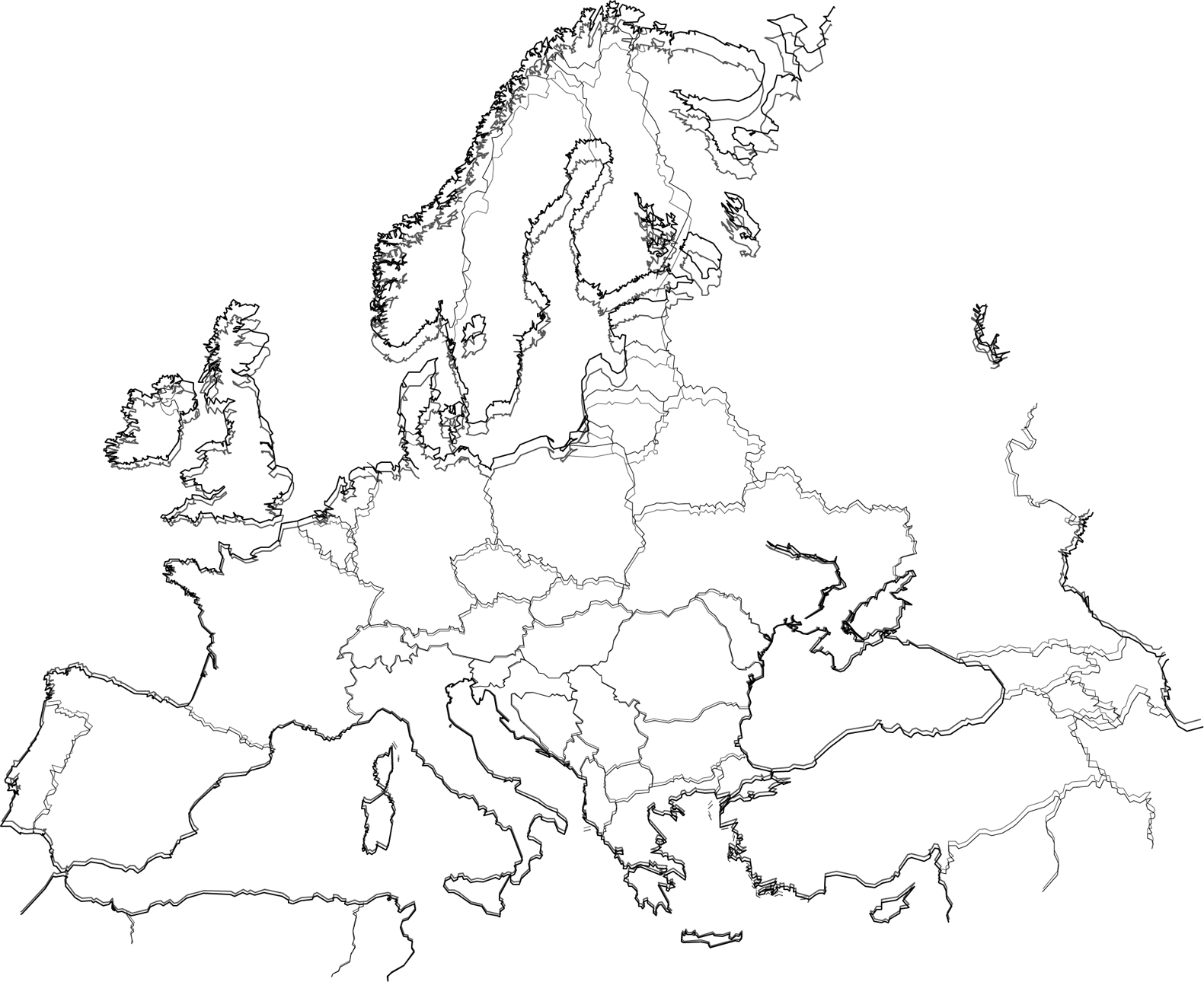
The map shown in Figure 3-25 was made with the following two commands and relies on the handy overlay feature in pscoast:
$ pscoast -JL15/50/40/65/18c -R-12/50/34/72 -W2/64/64/64 -N1/1/64/64/64 -A5000 -K > overlay.ps $ pscoast -JB15/50/40/65/18c -R-12/50/34/72 -W2 -N1 -A5000 -O >> overlay.ps
The first command generates the Lambert's projection in gray, using the -K command to tell pscoast to leave out the PostScript footers that indicate that the document is finished. The second command appends an Albers Equal-Area projection to the PostScript file using the -JB option, which utilizes the same projection parameters. The -O command tells pscoast to omit the PostScript headers from the second map, which will cause the second map to simply be drawn on top of the first. The -K and -O commands can be combined to successively overlay three or more layers of output from GMT.
3.8.4. Pseudocylindrical Projections
Some projections have a mathematical, rather than geometric, origin. The sinusoidal projection, for example, plots straight parallels against meridians that are curved relative to the cosine of the longitude. Imagine what you might get if you smoothed the ends of the cylinder to a point before attempting a Mercator projection, and you have the basic idea, which is why the sinusoidal projection is sometimes referred to as a pseudocylindrical projection. The result is shown in Figure 3-26, which we generated using the -JI option to pscoast.
Figure 3-26. A sinusoidal projection of the world
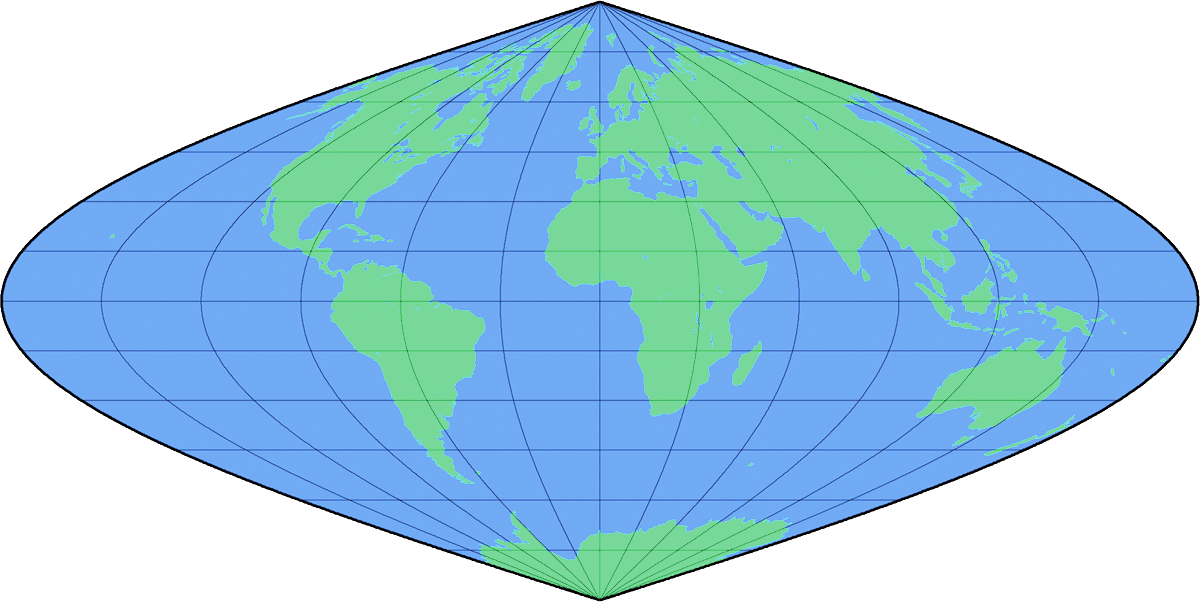
Although the sinusoidal projection distorts shapes rather badly away from the equator, it preserves land area, and it has the advantage of being nearly as easy to calculate as the Equidistant Cylindrical projection. Figure 3-27 shows a more aesthetically pleasing sinusoidal map of the world, made by interrupting the projection at 160ºW, 20ºE, and 60ºE.
Figure 3-27. An interrupted sinusoidal projection of the world
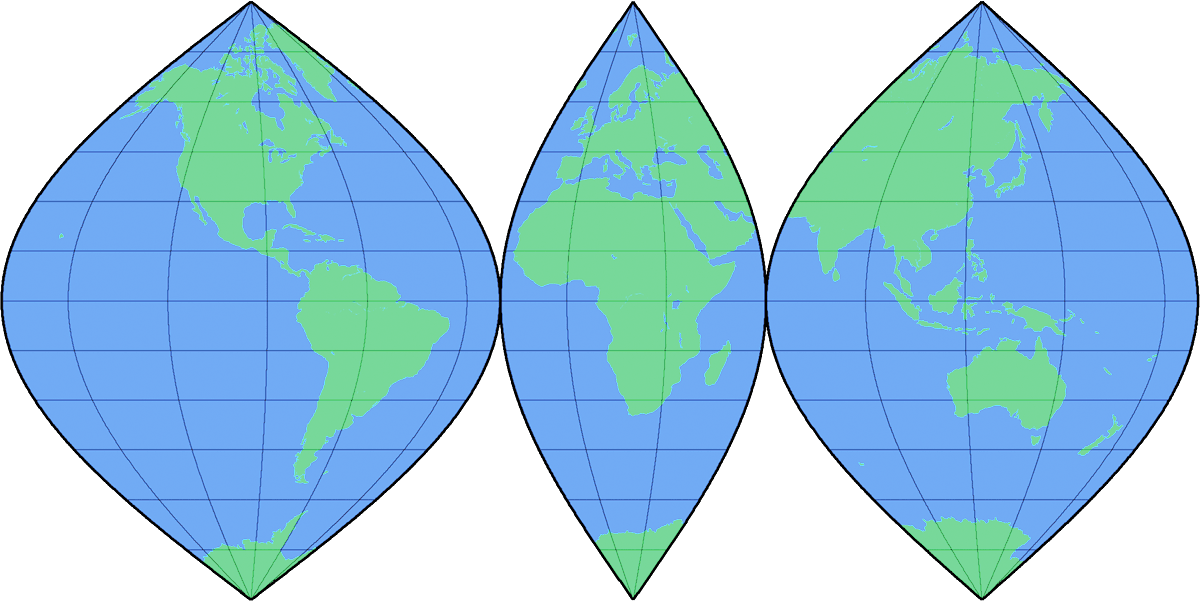
Figure 3-27 was generated with a shell script called sinusoidal.sh, containing the following commands:
#!/bin/sh pscoast -Ji-95/0.05c -R-170/-20/-90/90 -Bg30/g15 -G64/255/128 -S64/128/255 -A5000 -K pscoast -Ji20/0.05c -R-20/60/-90/90 -Bg30/g15 -G64/255/128 -S64/128/255 -A5000 -X7.5c -O -K pscoast -Ji125/0.05c -R60/190/-90/90 -Bg30/g15 -G64/255/128 -S64/128/255 -A5000 -X4c -O
The script was then run as follows:
$ sh ./sinusoidal.sh > sinusoidal.ps
In GMT, if a projection is specified with a lowercase letter (-Ji), rather than an uppercase letter (-JI), then the size measurement is taken to specify the width of a single degree at the equator (or standard parallel), rather than the size of the whole map. A 360-degree map of Earth at 0.05 cm per degree would therefore yield a map 18 cm wide. We used this style of pscoast invocation here because it made the value of the -X option, which specifies how far to offset each interrupted segment of the map along the x axis, a little easier to calculate. (pscoast also supports a -Y option.) Note the use of both -K and -O to allow overlays as described earlier.
3.8.5. Plotting Locations with GMT
We've by no means exhausted either the list of possible cartographic projections or the full range of GMT's features. GMT comes with a lot more tools than just pscoast, but we'll have to refer you to the documentation at http://gmt.soest.hawaii.edu/ to learn what else it can do. We'll just finish by highlighting the psxy command from GMT, which plots longitude/latitude points in PostScript.
Given a list of the longitudes and latitudes of the world's 50 largest cities, separated by commas, one pair per line, in a file called cities.txt, we can use psxy to plot them on a Robinson projection of the world. The Robinson projection is a modified cylindrical projection, popular for balancing the trade-offs in size and shape on world maps. In this example, we'll plot the cities with .25 cm wide red stars and center the map at 10ºE, in order to avoid splitting Siberia. We'll leave further exploration of the following GMT commands as an exercise for the gentle reader, but you can see the map they produce in Figure 3-28:
$ pscoast -JN10/18c -R-170/190/-90/90 -G64/255/128 -S64/128/255 -A5000 -K > cities.ps $ psxy cities.txt -JN10/18c -R-170/190/-90/90 -Bg30/g15 -Sa.25c -G255/0/0 -O >> cities.ps
Figure 3-28. The world's 50 largest cities, plotted on a Robinson projection
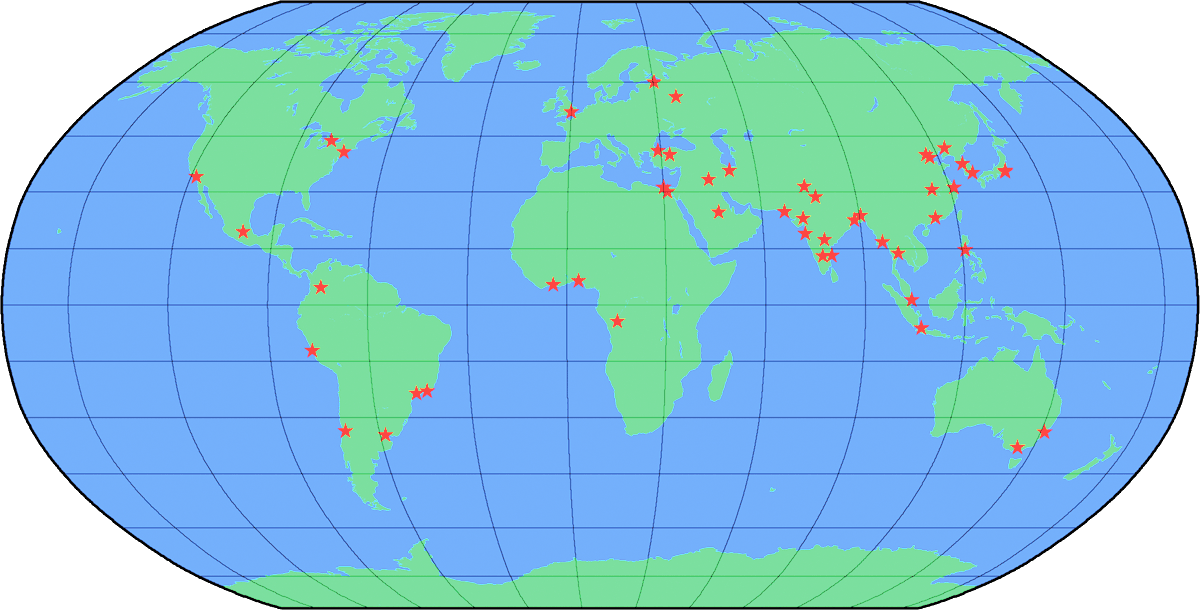
3.8.6. See Also
- [Hack #26]
- [Hack #29]
- [Hack #22]
- [Hack #31]
- Generic Mapping Tools home page (http://gmt.soest.hawaii.edu/)
- Online Map Creation site (http://www.aquarius.geomar.de/omc/)
Mapping Your Life
- Hacks 1-13
- Hack 1. Put a Map on It: Mapping Arbitrary Locations with Online Services
- Hack 2. Route Planning Online
- Hack 3. Map the Places Youve Visited
- Hack 4. Find Your House on an Aerial Photograph
- Hack 5. The Road Less Traveled by in MapQuest
- Hack 6. Make Route Maps Easier to Read
- Hack 7. Will the Kids Barf?
- Hack 8. Publish Maps of Your Photos on the Web
- Hack 9. Track the Friendly Skies with Sherlock
- Hack 10. Georeference Digital Photos
- Hack 11. How Far? How Fast? Geo-Enabling Your Spreadsheet
- Hack 12. Create a Distance Grid in Excel
- Hack 13. Add Maps to Excel Spreadsheets with MapPoint
Mapping Your Neighborhood
- Hacks 14-21
- Hack 14. Make Free Maps of the United States Online
- Hack 15. Zoom Right In on Your Neighborhood
- Hack 16. Who Are the Neighbors Voting For?
- Hack 17. Map Nearby Wi-Fi Hotspots
- Hack 18. Why You Cant Watch Broadcast TV
- Hack 19. Analyze Elevation Profiles for Wireless Community Networks
- Hack 20. Make 3-D Raytraced Terrain Models
- Hack 21. Map Health Code Violations with RDFMapper
Mapping Your World
- Hacks 22-34
- Hack 22. Digging to China
- Hack 23. Explore David Rumseys Historical Maps
- Hack 24. Explore a 3-D Model of the Entire World
- Hack 25. Work with Multiple Lat/Long Formats
- Hack 26. Work with Different Coordinate Systems
- Hack 27. Calculate the Distance Between Points on the Earths Surface
- Hack 28. Experiment with Different Cartographic Projections
- Hack 29. Plot Arbitrary Points on a World Map
- Hack 30. Plot a Great Circle on a Flat Map
- Hack 31. Plot Dymaxion Maps in Perl
- Hack 32. Hack on Base Maps in Your Favorite Image Editor
- Hack 33. Georeference an Arbitrary Tourist Map
- Hack 34. Map Other Planets
Mapping (on) the Web
- Hacks 35-46
- Hack 35. Search Local, Find Global
- Hack 36. Shorten Online Map URLs
- Hack 37. Tweak the Look and Feel of Web Maps
- Hack 38. Add Location to Weblogs and RSS Feeds
- Hack 39. View Your Photo Thumbnails on a Flash Map
- Hack 40. Plot Points on a Spinning Globe Applet
- Hack 41. Plot Points on an Interactive Map Using DHTML
- Hack 42. Map Your Tracklogs on the Web
- Hack 43. Map Earthquakes in (Nearly) Real Time
- Hack 44. Plot Statistics Against Shapes
- Hack 45. Extract a Spatial Model from Wikipedia
- Hack 46. Map Global Weather Conditions
Mapping with Gadgets
- Hacks 47-63
- How GPS Works
- Hack 47. Get Maps on Your Mobile Phone
- Hack 48. Accessorize Your GPS
- Hack 49. Get Your Tracklogs in Windows or Linux
- Hack 50. The Serial Port to USB Conundrum
- Hack 51. Speak in Geotongues: GPSBabel to the Rescue
- Hack 52. Show Your Waypoints on Aerial Photos with Terrabrowser
- Hack 53. Visualize Your Tracks in Three Dimensions
- Hack 54. Create Your Own Maps for a Garmin GPS
- Hack 55. Use Your Track Memory as a GPS Base Map
- Hack 56. Animate Your Tracklogs
- Hack 57. Connect to Your GPS from Multiple Applications
- Hack 58. Dont Lose Your Tracklogs!
- Hack 59. Geocode Your Voice Recordings and Other Media
- Hack 60. Improve the Accuracy of Your GPS with Differential GPS
- Hack 61. Build a Map of Local GSM Cells
- Hack 62. Build a Car Computer
- Hack 63. Build Your Own Car Navigation System with GpsDrive
Mapping on Your Desktop
- Hacks 64-77
- Hack 64. Mapping Local Areas of Interest with Quantum GIS
- Hack 65. Extract Data from Maps with Manifold
- Hack 66. Java-Based Desktop Mapping with Openmap
- Hack 67. Seamless Data Download from the USGS
- Hack 68. Convert Geospatial Data Between Different Formats
- Hack 69. Find Your Way Around GRASS
- Hack 70. Import Your GPS Waypoints and Tracklogs into GRASS
- Hack 71. Turn Your Tracklogs into ESRI Shapefiles
- Hack 72. Add Relief to Your Topographic Maps
- Hack 73. Make Your Own Contour Maps
- Hack 74. Plot Wireless Network Viewsheds with GRASS
- Hack 75. Share Your GRASS Maps with the World
- Hack 76. Explore the Effects of Global Warming
- Conclusion
- Hack 77. Become a GRASS Ninja
Names and Places
- Hacks 78-86
- Hack 78. What to Do if Your Government Is Hoarding Geographic Data
- Hack 79. Geocode a U.S. Street Address
- Hack 80. Automatically Geocode U.S. Addresses
- Hack 81. Clean Up U.S. Addresses
- Hack 82. Find Nearby Things Using U.S. ZIP Codes
- Hack 83. Map Numerical Data the Easy Way
- Hack 84. Build a Free World Gazetteer
- Hack 85. Geocode U.S. Locations with the GNIS
- Hack 86. Track a Package Across the U.S.
Building the Geospatial Web
- Hacks 87-92
- Hack 87. Build a Spatially Indexed Data Store
- Hack 88. Load Your Waypoints into a Spatial Database
- Hack 89. Publish Your Geodata to the Web with GeoServer
- Hack 90. Crawl the Geospatial Web with RedSpider
- Hack 91. Build Interactive Web-Based Map Applications
- Hack 92. Map Wardriving (and other!) Data with MapServer
Mapping with Other People
- Hacks 93-100
- Hack 93. Node Runner
- Hack 94. Geo-Warchalking with 2-D Barcodes
- Hack 95. Model Interactive Spaces
- Hack 96. Share Geo-Photos on the Web
- Hack 97. Set Up an OpenGuide for Your Hometown
- Hack 98. Give Your Great-Great-Grandfather a GPS
- Hack 99. Map Your Friend-of-a-Friend Network
- Hack 100. Map Imaginary Places
EAN: 2147483647
Pages: 172


